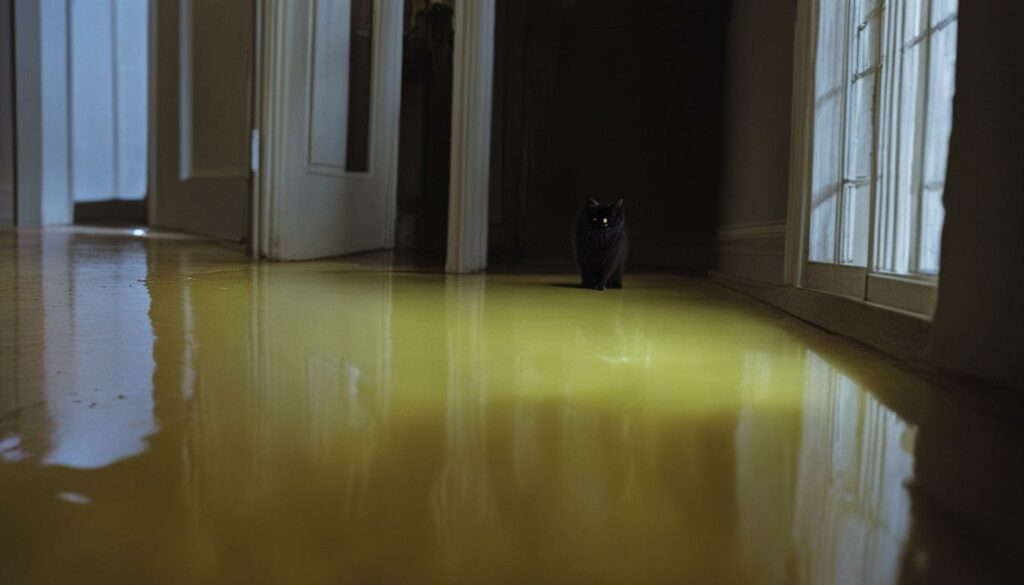Cats peeing in the same spot on the floor can be a frustrating and perplexing behavior for cat owners. Understanding the intricacies behind this issue is crucial in order to find effective solutions. Let’s delve into the reasons why cats exhibit this behavior and explore potential remedies.
Key Takeaways:
- Understanding cat behavior and territorial marking can help address the issue of cats peeing in the same spot on the floor.
- Potential reasons for inappropriate elimination include litter box aversion, urinary tract infections, and changes in the environment.
- Addressing litter box issues and using behavior modification techniques can help resolve the problem.
- Seeking veterinary care is important if the issue persists or is accompanied by signs of discomfort or illness.
- Utilizing cat pheromones and odor deterrents can discourage cats from peeing in the same spot.
Understanding Cat Behavior and Territorial Marking
Cats are fascinating creatures with complex behaviors. One of the behaviors that can be perplexing for cat owners is when their feline companion repeatedly pees in the same spot on the floor. To unravel this behavior, it’s important to understand the concept of territorial marking.
Territorial marking is a natural instinct in cats. Through various methods such as spraying and scent marking, cats communicate and establish ownership of their territory. When a cat pees in the same spot on the floor, it can be a form of territorial marking, as they leave their scent behind as a way to communicate with other cats and claim their territory.

Spraying is a common means of territorial marking in both male and female cats. It involves the release of a strong-smelling urine that contains pheromones, signaling their presence and dominance. Understanding this marking behavior can help us address the issue effectively and find appropriate solutions.
Potential Reasons for Inappropriate Elimination
When a cat repeatedly pees in the same spot on the floor instead of using the litter box, there can be several potential reasons behind this behavior. Understanding these reasons is essential in order to address the issue effectively.
One possible cause is litter box aversion. Cats may develop a negative association with their litter box due to factors such as discomfort, dirty litter, or location. This can lead them to seek alternative spots to eliminate, such as the same spot on the floor.
Additionally, urinary tract infections or other medical issues can also cause cats to avoid their litter boxes. Cats with urinary tract infections may associate the pain or discomfort of urinating with the litter box, leading them to seek alternate areas to relieve themselves.
In some cases, improper litter training or a change in the environment can contribute to the cat’s inappropriate elimination behavior. Cats may become confused or stressed by changes in their surroundings, leading them to choose a different spot to eliminate.
To better understand and address the specific reason behind a cat’s inappropriate elimination behavior, it is important to observe their behavior, consult with a veterinarian, and make any necessary adjustments to the litter box and environment.
Addressing Litter Box Issues
When dealing with a cat peeing in the same spot on the floor, it is important to address any issues with the litter box. The condition and cleanliness of the litter box can play a significant role in a cat’s elimination behavior. Ensure the litter box is clean and appropriately sized for your cat. Cats are very particular about cleanliness and may refuse to use a dirty litter box. Scoop the litter box at least once a day to remove waste and clumps, and completely replace the litter every 1-2 weeks. Consider using a litter that is unscented, as some cats are sensitive to strong odors.
Using cat-friendly cleaning products to eliminate urine stains and odors is crucial in preventing the cat from returning to the same spot. Cats have a highly developed sense of smell, and if they can detect any lingering urine scent, they may continue to use that area as their elimination spot. Look for enzymatic cleaners specifically designed to break down the odor-causing compounds in cat urine. Follow the instructions on the cleaning products and thoroughly clean affected surfaces to ensure the complete removal of odors and stains.
Understanding feline behavior and cat psychology
can provide valuable insights into resolving litter box issues. Cats may avoid their litter boxes due to stress, anxiety, or fear. Ensure the litter box is placed in a quiet and accessible area where the cat feels safe and secure. Avoid placing the litter box near loud noises or areas with heavy foot traffic. Creating a positive association with the litter box by rewarding your cat with treats or praise when they use it can also encourage proper litter box usage.If your cat continues to avoid the litter box despite addressing any potential issues, it may be beneficial to consult with a veterinarian or a professional cat behaviorist. They can help identify any underlying medical conditions or provide guidance on behavior modification techniques tailored to your cat’s specific needs. Remember, each cat is unique, and finding the most effective solution may require individualized approaches.
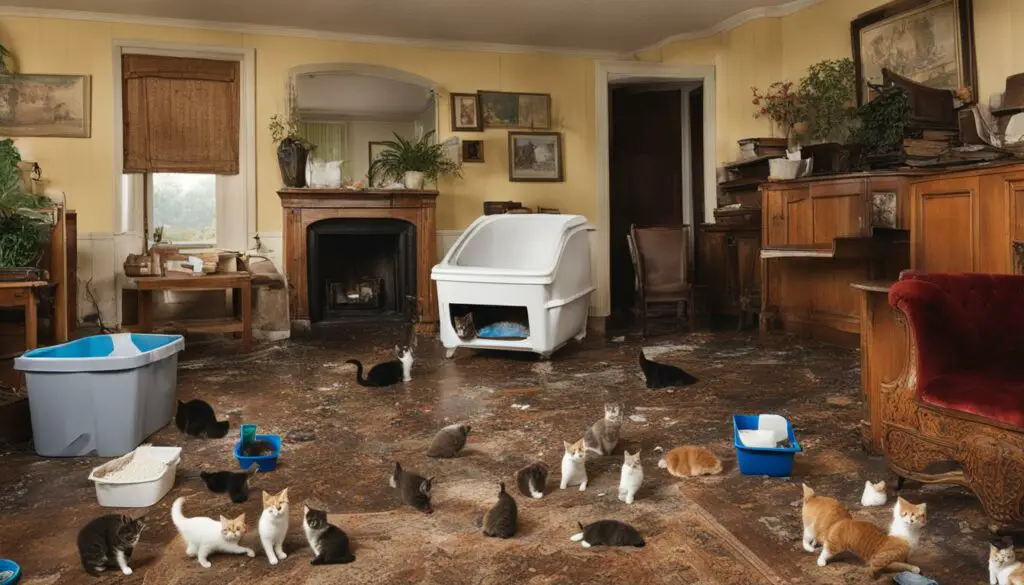
Behavioral Modification Techniques
When dealing with a cat peeing in the same spot on the floor, it is essential to implement behavioral modification techniques to address the underlying issue. These techniques focus on modifying the cat’s marking behavior and encouraging them to use the litter box instead. Consistency and positive reinforcement are key to the success of these techniques.
Positive Reinforcement
A primary approach to behavior modification is utilizing positive reinforcement. This involves rewarding your cat for using the litter box correctly and providing them with praise and treats. Whenever your cat successfully uses the litter box, immediately offer verbal praise and a small treat. This positive reinforcement helps create a positive association with the litter box and encourages them to continue exhibiting appropriate elimination behavior.
“I found that using a clicker to mark the desired behavior, followed by a treat, was highly effective in modifying my cat’s marking behavior,” says Jennifer, a cat parent who successfully addressed her cat’s urine marking problem.
“By consistently rewarding my cat when she used the litter box, she began to associate the behavior with positive outcomes. Over time, the marking behavior significantly decreased.”
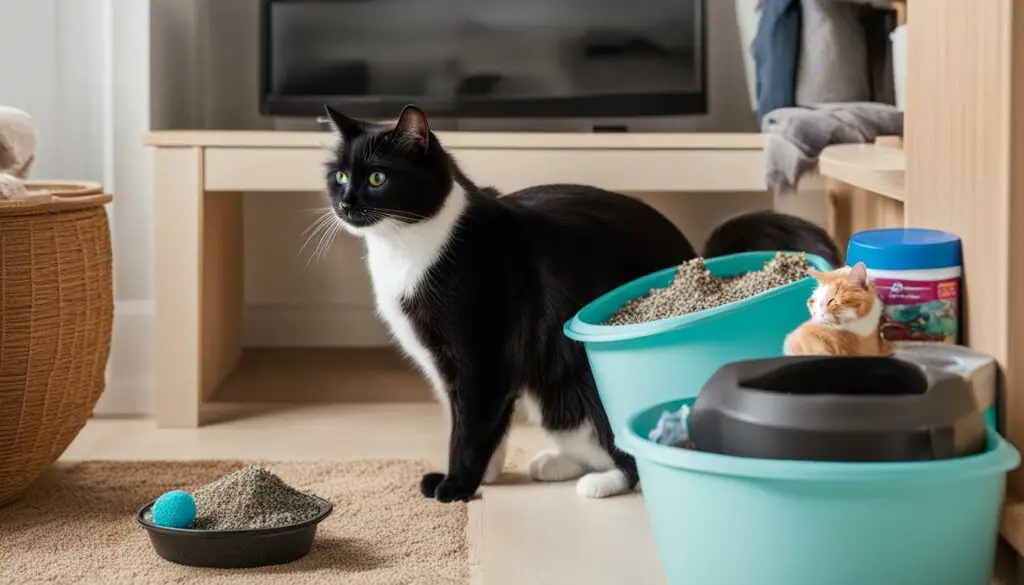
Environmental Enrichment
Creating a stimulating environment for your cat can also aid in modifying marking behavior. Provide plenty of interactive toys, scratching posts, and vertical spaces for your cat to explore and play. By offering outlets for their natural behaviors, such as scratching and climbing, you can redirect their marking instincts to more appropriate areas.
In addition, consider using pheromone diffusers or sprays in the areas where your cat tends to mark. These pheromones can help create a sense of familiarity and security, reducing the need for marking behavior.
Consulting a Professional
If you’re struggling to modify your cat’s marking behavior on your own, it may be beneficial to seek the guidance of a professional cat behaviorist. These experts can assess your cat’s specific situation and provide tailored advice and strategies to address the marking behavior. They can also help identify any underlying factors contributing to the marking behavior and offer additional recommendations to alleviate the issue.
| Behavioral Modification Techniques | Effectiveness |
|---|---|
| Positive Reinforcement | Highly effective for many cats |
| Environmental Enrichment | Can significantly reduce marking behavior |
| Consulting a Professional | Recommended for complex cases or lack of progress |
Seeking Veterinary Care
If the issue of a cat peeing in the same spot on the floor persists or is accompanied by other signs of discomfort or illness, it is important to seek veterinary care. Cats may exhibit inappropriate elimination behavior due to underlying health issues, such as a urinary tract infection (UTI) or other medical conditions. A thorough examination by a veterinarian, including a urinalysis, can help identify and treat any underlying health problems that may be contributing to the behavior.
When a cat has a UTI, the feline urine may have an unusual odor and the cat may exhibit increased frequency of urination or discomfort while urinating. A veterinarian can provide the appropriate treatment, which may involve antibiotics or other medications to alleviate the infection and resolve the inappropriate elimination behavior. It is crucial to address any medical concerns as they can significantly impact a cat’s overall health and wellbeing.
Additionally, a veterinarian can offer guidance on managing cat urine odor and eliminating lingering urine stains. They can recommend specific cleaning products and techniques that are safe for both the cat and the environment. By addressing any underlying medical issues and seeking veterinary care, cat owners can ensure the health and happiness of their beloved feline companions.
Remember, each cat is unique, and finding the most effective solution to address a cat peeing in the same spot on the floor may require individualized approaches. Seeking veterinary care is an important step in the process of resolving this behavior and providing the best care for your cat.

The Power of Cat Pheromones and Urine Marking Deterrents
When it comes to addressing a cat peeing in the same spot on the floor, utilizing cat pheromones and urine marking deterrents can be highly effective. Cat pheromones, available in synthetic sprays or diffusers, work by creating a sense of familiarity and security for the cat, helping to reduce urine marking behavior. These pheromones mimic the natural scent signals cats use to mark their territory, signaling to the cat that the area has already been marked and doesn’t need further marking.
In addition to cat pheromones, urine marking deterrents can be used to discourage the cat from continuing to pee in the same spot. These deterrents often utilize scents that cats find aversive, such as citrus, to create an unpleasant experience. There are also commercially available products specifically designed to deter urine marking behavior. By using these deterrents in the marked area, you can help break the cat’s habit of using that spot as a bathroom.
It’s important to note that while cat pheromones and urine marking deterrents can be effective, they are not a standalone solution. These products should be used in conjunction with other behavior modification techniques and environmental changes to address the underlying issues contributing to the cat’s urine marking behavior. Consistency and patience are key when implementing these strategies, as it may take time for the cat to adjust to the new scent signals and deterrents.
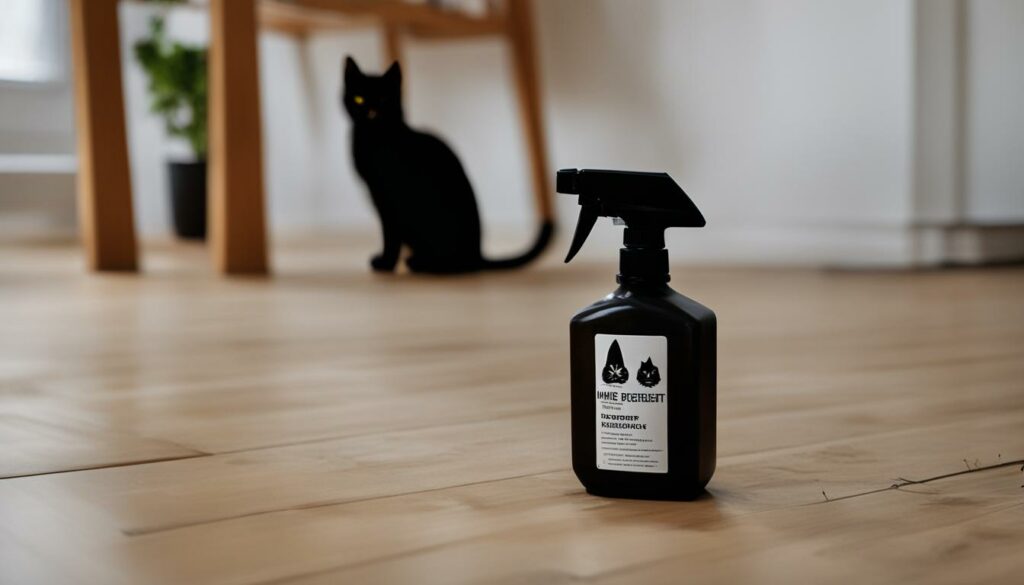
Considering the Use of Cat Pheromones and Deterrents
Before utilizing cat pheromones or urine marking deterrents, it’s important to consult with your veterinarian to rule out any underlying medical issues that may be causing the inappropriate elimination behavior. If your cat is suffering from a urinary tract infection or other health problem, addressing the medical issue will be necessary in addition to implementing behavior modification techniques.
Once you have the green light from your veterinarian, you can begin incorporating cat pheromones and urine marking deterrents into your plan to help deter the cat from peeing in the same spot on the floor. Follow the product instructions carefully and be consistent in their use. In conjunction with other strategies such as providing a positive litter box environment and implementing behavior modification techniques, cat pheromones and urine marking deterrents can significantly contribute to resolving this challenging behavior.
Creating a Positive Litter Box Environment
When it comes to addressing a cat’s tendency to pee in the same spot on the floor, creating a positive litter box environment is crucial. By providing a space that meets their needs and preferences, we can encourage cats to use their litter boxes instead of marking their territory indoors.
Here are some important factors to consider:
- Litter box accessibility: Ensure that the litter box is easily accessible for your cat. It should be located in a quiet area away from sources of stress or potential disturbances. Cats prefer privacy when using the litter box, so choose a spot that offers a sense of seclusion.
- Appropriate litter box size: Make sure the litter box is large enough for your cat to comfortably move around in. Cats need space to dig and bury their waste, so a litter box that is too small may discourage them from using it properly.
- Multiple litter boxes: If you have multiple cats, provide multiple litter boxes in different locations. This helps prevent competition and territorial disputes over litter box access, reducing the likelihood of indoor marking.
By implementing these strategies, we can create an environment that promotes proper litter box usage and discourages inappropriate elimination. Remember to be patient and consistent in your approach, as it may take time for your cat to adjust to the changes. Providing a positive litter box experience is essential for maintaining a harmonious home environment.
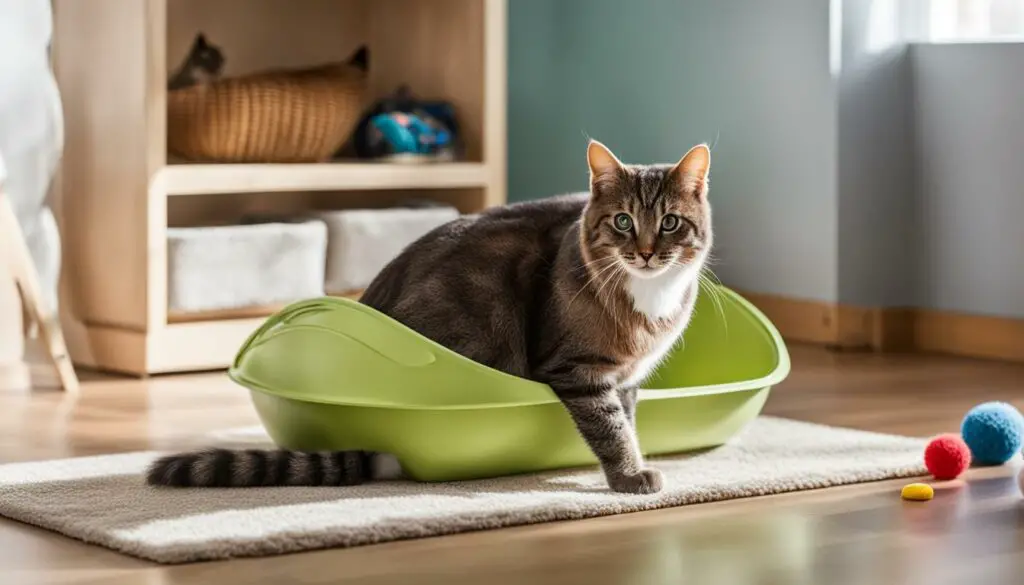
Additional Tip:
“Regular cleaning and maintenance of the litter box is crucial to ensure your cat’s comfort and hygiene. Scoop the litter box daily and change the litter regularly to prevent odors and hygiene issues. Cats are fastidious creatures and may avoid using a dirty litter box.”
Preventing Future Instances of Urine Marking
Preventing future instances of urine marking involves implementing proactive measures to discourage the behavior and create a more suitable environment for your cat. By addressing the underlying causes and providing appropriate alternatives, you can effectively minimize urine marking and promote healthier habits for your feline companion.
Creating an Environment Marking Scent
One important step in preventing urine marking is to eliminate any lingering marking scent that may attract your cat to the same spot. Using enzymatic cleaners specifically designed for removing cat urine odors can help eliminate the scent and deter future marking behavior. These cleaners break down the urine molecules and neutralize the odor, making the area less appealing to your cat.
Additionally, providing your cat with designated marking spots can redirect their marking behavior. Use urine marking deterrents, such as synthetic pheromone sprays, on the areas where you want your cat to mark. These sprays mimic the scent produced by cats when they rub against objects to mark their territory, and can help guide your cat to appropriate marking locations.
Marking Behavior in Cats
It’s also essential to identify and address any underlying causes of marking behavior in your cat. Stress and anxiety can contribute to urine marking, so creating a calm and stress-free environment is crucial. Provide your cat with plenty of vertical space, such as cat trees or shelves, to help them feel more secure and in control of their territory.
In some cases, it may be beneficial to consult with a veterinarian or a professional cat behaviorist for additional guidance. They can help assess your cat’s behavior and provide personalized recommendations to prevent future instances of urine marking.
| Prevention Tips for Urine Marking | Benefits |
|---|---|
| Regularly clean marked areas with enzymatic cleaners | Eliminates lingering marking scent |
| Provide designated marking spots with urine marking deterrents | Redirects marking behavior to appropriate locations |
| Create a calm and stress-free environment | Reduces anxiety and decreases the likelihood of marking |
| Consult a veterinarian or cat behaviorist for personalized guidance | Receive expert advice tailored to your cat’s specific needs |
By following these prevention tips and being proactive in addressing urine marking behavior, you can create a harmonious living space for both you and your feline friend.
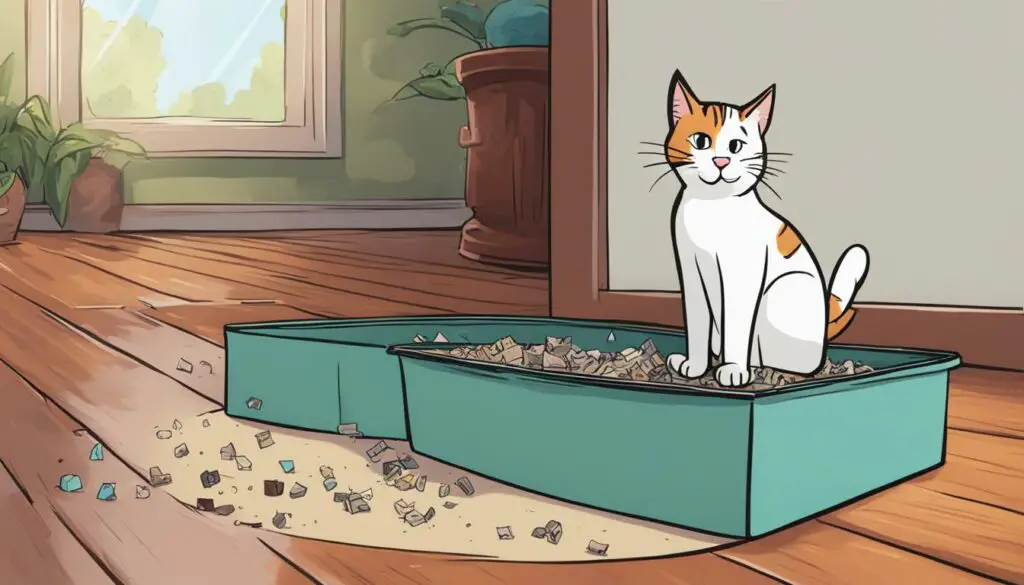
Eliminating Lingering Urine Odors and Stains
Dealing with a cat peeing in the same spot on the floor can leave behind unpleasant urine odors and stains. It’s important to address these issues to prevent the cat from continuing to use that area as a designated elimination spot. Here are some effective methods for removing cat urine odor and stains.
Use Enzymatic Cleaners
Enzymatic cleaners are specifically designed to break down the proteins present in cat urine, effectively eliminating the odor. These cleaners work by neutralizing the urine molecules, rather than just masking the smell. It’s important to follow the instructions on the cleaning product and thoroughly clean the affected area to ensure complete removal of the odor. Using an enzymatic cleaner will not only eliminate the odor but also discourage the cat from returning to that spot.
Remove Stains with Baking Soda and Vinegar
If there are visible urine stains on the floor, a combination of baking soda and vinegar can help remove them. First, blot the area with a paper towel or cloth to remove any excess moisture. Then, sprinkle baking soda over the stain and let it sit for a few minutes. Next, mix equal parts vinegar and water in a spray bottle and lightly mist the stained area. Allow the mixture to sit for a few minutes and then scrub the stain with a clean cloth or sponge. Rinse the area with water and blot dry. This method can effectively remove urine stains and help eliminate lingering odors.
Consider Steam Cleaning
If the lingering urine odor persists, steam cleaning the affected area can help remove it. Steam cleaning uses hot water vapor to deep clean the carpet or flooring, effectively removing any embedded urine particles. It’s important to use a pet-safe steam cleaner and follow the manufacturer’s instructions. Steam cleaning not only eliminates urine odors but also sanitizes the area, ensuring a clean and fresh environment for both you and your cat.
By using enzymatic cleaners, a combination of baking soda and vinegar, or steam cleaning, you can successfully eliminate lingering urine odors and stains. Remember to address the issue promptly to discourage the cat from returning to the same spot. Creating a clean and odor-free environment will help ensure a happy and healthy living space for both you and your feline companion.
Considering Professional Help or Consultation
Dealing with a cat peeing in the same spot on the floor can be a challenging issue for cat parents. If you have tried various strategies and remedies without success, it may be time to consider seeking professional help or consulting with a cat behaviorist. These experts specialize in feline behavior and can provide valuable insights and guidance tailored to your specific situation.
A cat behaviorist can thoroughly evaluate your cat’s environment, assess their marking behavior, and identify any underlying factors contributing to the problem. They can offer behavior modification techniques that are specifically tailored to address your cat’s marking behavior. With their expertise, they can help you find the most effective solutions and strategies to manage or resolve the issue.
Professional help or consultation is particularly recommended if your cat’s marking behavior is accompanied by other signs of distress, such as excessive vocalization, changes in appetite, or aggression. These experts can work alongside your veterinarian to ensure that any potential medical issues are ruled out or addressed.
Ultimately, seeking professional help or consultation can provide you with the knowledge and support necessary to tackle your cat’s marking behavior effectively. By collaborating with an expert, you can better understand your cat’s unique behavior and work towards a resolution that improves your cat’s well-being and creates a harmonious living environment for both you and your feline companion.
Table: Pros and Cons of Seeking Professional Help
| Pros | Cons |
|---|---|
| Expert insights and guidance | Additional cost |
| Tailored strategies and solutions | Time commitment |
| Collaboration with veterinarian | Potential need for multiple sessions |
| Improved understanding of feline behavior | No guaranteed “quick-fix” solution |
| Potential identification of underlying medical issues | Additional adjustments and implementation required |
Note: It is important to research and choose a reputable and certified cat behaviorist to ensure you are receiving credible advice and assistance.
Additional Tips for Managing the Issue
If you’re dealing with a cat peeing in the same spot on the floor, there are a few additional tips that can aid in managing this issue. Providing ample playtime and mental stimulation for your cat can help alleviate any stress or boredom that may contribute to marking behavior. Interactive toys and puzzles can keep your cat engaged and redirect their focus away from marking territory. Additionally, establishing a routine for feeding and cleaning can help create a sense of stability and security for your cat.
Creating a calm and stress-free environment is crucial for preventing marking behavior. Reduce any sources of stress or anxiety in your cat’s surroundings, such as loud noises or conflict with other pets. Consider using pheromone diffusers or sprays, which can help create a sense of familiarity and security in your cat’s territory.
Consistency and positive reinforcement are key when managing marking behavior. Reward your cat for using their litter box and provide praise and treats to reinforce this desired behavior. Avoid punishment, as it can exacerbate stress and anxiety. Instead, focus on rewarding and redirecting your cat’s behavior to a more appropriate location.

Table: Comparing Different Urine Marking Solutions
| Solution | Pros | Cons |
|---|---|---|
| Behavior modification | – Addresses underlying causes – Positive reinforcement – Can be effective long-term |
– Requires time and patience – May not work for all cats |
| Use of pheromones | – Creates a sense of security – Reduces stress and anxiety – Easy to use |
– May not be effective for all cats – Can be costly |
| Veterinary care | – Identifies underlying health issues – Provides appropriate treatment – Ensures overall well-being |
– Can be expensive – Requires regular check-ups |
Remember, each cat is unique, and finding the most effective solution may require individualized approaches. Don’t hesitate to consult with a veterinarian or a cat behaviorist for personalized guidance and support. With patience, understanding, and the right strategies, you can successfully manage and minimize your cat’s urine marking behavior.
Section 13: Conclusion
Dealing with a cat peeing in the same spot on the floor requires patience, understanding, and a multi-faceted approach. By addressing potential litter box issues, implementing behavior modification techniques, seeking veterinary care, and creating a positive environment, it is possible to resolve or manage the issue. Remember, each cat is unique, and finding the most effective solution may require individualized approaches.
Start by examining the litter box situation. Ensure it is clean, appropriately sized, and in a quiet area. Consider using cat-friendly cleaning products to eliminate urine stains and odors. Understanding your cat’s behavior and psychology can also help address litter box issues effectively.
If the problem persists or if your cat displays signs of discomfort or illness, seek veterinary care. Urinary tract infections or other medical conditions may be contributing to the inappropriate elimination behavior. A thorough examination and appropriate treatment can make a significant difference.
Lastly, create a positive litter box environment and consider utilizing cat pheromones or odor deterrents. These techniques can help prevent future instances of urine marking. Additionally, provide a stimulating environment with scratching posts and interactive toys to redirect your cat’s marking behavior.
Remember, finding the right solution may take time and experimentation. Don’t hesitate to seek professional help or consultation from cat behaviorists if needed. With dedication and the right approach, you can overcome this challenge and create a harmonious living space for you and your feline companion.
FAQ
Why is my cat peeing in the same spot on the floor?
Cats may pee in the same spot on the floor for various reasons, including territorial marking, litter box aversion, medical issues, or changes in the environment.
How can I address litter box issues?
To address litter box issues, make sure the litter box is clean and appropriately sized. Use cat-friendly cleaning products to eliminate urine stains and odors, and consider understanding feline behavior and cat psychology.
What are some behavioral modification techniques to stop urine marking?
Behavioral modification techniques involve positive reinforcement, like rewarding your cat for using the litter box and providing praise and treats. Consistency and patience are key when implementing these techniques.
Should I seek veterinary care if my cat keeps peeing in the same spot?
Yes, it is important to seek veterinary care to rule out any underlying medical conditions, such as urinary tract infections. A thorough examination, including urinalysis, can help identify and treat any health issues contributing to the problem.
How can cat pheromones and odor deterrents help with urine marking?
Cat pheromones can create a sense of familiarity and security, reducing urine marking behavior. Odor deterrents, like citrus scents or commercial products, can also discourage cats from peeing in the same spot.
What can I do to create a positive litter box environment?
Ensure the litter box is easily accessible, in a quiet area, and away from sources of stress or disturbances. Providing multiple litter boxes in different locations can also help prevent indoor marking and litter box avoidance.
How can I prevent future instances of urine marking?
Regularly clean and maintain the litter boxes, use unscented litter, and provide enough litter boxes for all cats in the household. Additionally, create a stimulating environment with scratching posts and interactive toys to redirect marking behavior.
How do I eliminate lingering urine odors and stains?
Use enzymatic cleaners specifically designed for eliminating cat urine odors. Follow the instructions on the cleaning products and thoroughly clean affected surfaces to ensure the complete removal of odors and stains.
Should I consider professional help or consultation?
If the issue persists, it may be necessary to seek professional help or consult with a cat behaviorist. They can provide expert advice tailored to address your cat’s specific marking behavior and assist in finding the best solution.
Any additional tips for managing the issue?
Provide ample playtime and mental stimulation for your cat, establish a routine for feeding and cleaning, and create a calm and stress-free environment. Consistency and positive reinforcement are key in training and modifying behavior.

